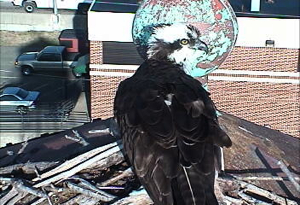VIMS announces launch of “OspreyCam”
The Virginia Institute of Marine Science announces the launch of a new “OspreyCam” that allows public viewing of an osprey family during its annual nesting and breeding season on the shores of Chesapeake Bay. That season typically runs from early March through July.
The real-time video feed (www.vims.edu/osprey) comes from a nest that sits atop a 65-foot water tower on the VIMS campus in Gloucester Point. The nest site has been occupied every breeding season for several decades. The OspreyCam was first erected in spring 2011 and recently raised to provide a better view into the nest. Installation was accomplished with help from SignMedia of Hampton.
 Ospreys are of particular interest to researchers at VIMS because
they are the only birds of prey that subsist almost exclusively on a diet of live
fishes—hence their common name of "fish hawks."
Ospreys are of particular interest to researchers at VIMS because
they are the only birds of prey that subsist almost exclusively on a diet of live
fishes—hence their common name of "fish hawks."
Fisheries scientists, including those involved in the Chesapeake Bay Multispecies Monitoring and Assessment Program (ChesMMAP) at VIMS, are increasingly shifting their focus from studies of single species to broader investigations that consider the interactions among species in an ecosystem. Ospreys are part of those interactions, feeding on a number of commercially and recreationally important Bay fishes such as menhaden, white perch, croaker, oyster toadfish, and American eel.
Dr. Rob Latour, head of the ChesMMAP program at VIMS, says “Ospreys are a notable part of the Chesapeake Bay ecosystem, preying on many species of fish and providing a highly visible reminder of the important links between water, air, and land.” Fish comprise more than 99% of the osprey’s diet. Unlike bald eagles, they usually feed on live prey, not carrion.
The VIMS water tower—which supplies irrigation water to the VIMS campus—provides an ideal nesting site for ospreys, with good visibility, limited access for predators, and easy access to nearby fishing grounds on the York River.
The nest itself—a 5-foot-wide thicket of sticks and other debris—is one of a growing number of nest sites around Chesapeake Bay. Osprey populations have been increasing in the Bay region and other U.S. water bodies since the late 1970s, primarily due to the 1972 ban on the widespread use of DDT.
The Bay has historically supported the largest concentration of breeding ospreys in the world. Breeding pairs repeatedly return to the same nest site, and often remain together for many years.
The OspreyCam joins a number of other online tools that VIMS provides to help citizens understand, appreciate, and enjoy Chesapeake Bay. These tools include a “UFO” service to help Bay enthusiasts identify unfamiliar marine organisms; a “Tidewatch” website for real-time information on storm surge and coastal flooding; a selection of 30-second BayWatch video clips on the living resources and natural history of the Bay; the Virginia Estuarine and Coastal Observing System (VECOS), an online source of water-quality data for the Bay and its tributaries; and other products (www.vims.edu/bayinfo).

